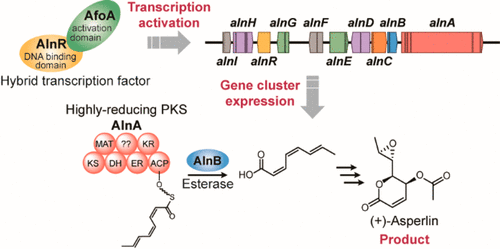当前位置:
X-MOL 学术
›
ACS Chem. Biol.
›
论文详情
Our official English website, www.x-mol.net, welcomes your
feedback! (Note: you will need to create a separate account there.)
Hybrid Transcription Factor Engineering Activates the Silent Secondary Metabolite Gene Cluster for (+)-Asperlin in Aspergillus nidulans
ACS Chemical Biology ( IF 3.5 ) Pub Date : 2018-10-19 00:00:00 , DOI: 10.1021/acschembio.8b00679 Michelle F. Grau,Ruth Entwistle,Yi-Ming Chiang,Manmeet Ahuja,C. Elizabeth Oakley,Tomohiro Akashi,Clay C. C. Wang,Richard B. Todd,Berl R. Oakley
ACS Chemical Biology ( IF 3.5 ) Pub Date : 2018-10-19 00:00:00 , DOI: 10.1021/acschembio.8b00679 Michelle F. Grau,Ruth Entwistle,Yi-Ming Chiang,Manmeet Ahuja,C. Elizabeth Oakley,Tomohiro Akashi,Clay C. C. Wang,Richard B. Todd,Berl R. Oakley

|
Fungi are a major source of valuable bioactive secondary metabolites (SMs). These compounds are synthesized by enzymes encoded by genes that are clustered in the genome. The vast majority of SM biosynthetic gene clusters are not expressed under normal growth conditions, and their products are unknown. Developing methods for activation of these silent gene clusters offers the potential for discovering many valuable new fungal SMs. While a number of useful approaches have been developed, they each have limitations, and additional tools are needed. One approach, upregulation of SM gene cluster-specific transcription factors that are associated with many SM gene clusters, has worked extremely well in some cases, but it has failed more often than it has succeeded. Taking advantage of transcription factor domain modularity, we developed a new approach. We fused the DNA-binding domain of a transcription factor associated with a silent SM gene cluster with the activation domain of a robust SM transcription factor, AfoA. Expression of this hybrid transcription factor activated transcription of the genes in the target cluster and production of the antibiotic (+)-asperlin. Deletion of cluster genes confirmed that the cluster is responsible for (+)-asperlin production, and we designate it the aln cluster. Separately, coinduction of expression of two aln cluster genes revealed the pathway intermediate (2Z,4Z,6E)-octa-2,4,6-trienoic acid, a compound with photoprotectant properties. Our findings demonstrate the potential of our novel synthetic hybrid transcription factor strategy to discover the products of other silent fungal SM gene clusters.
中文翻译:

杂合转录因子工程激活了构巢曲霉中(+)-阿斯匹林沉默的次生代谢产物基因簇。
真菌是有价值的生物活性次生代谢物(SM)的主要来源。这些化合物由基因组中簇集的基因编码的酶合成。绝大多数SM生物合成基因簇在正常生长条件下不表达,其产物未知。开发用于激活这些沉默基因簇的方法为发现许多有价值的新真菌SM提供了潜力。尽管已经开发了许多有用的方法,但是它们各有局限性,并且需要其他工具。一种方法是上调与许多SM基因簇相关的SM基因簇特异性转录因子,在某些情况下效果非常好,但失败的次数多于成功的次数。利用转录因子域模块性,我们开发了一种新方法。我们将与沉默SM基因簇相关的转录因子的DNA结合结构域与稳健的SM转录因子AfoA的激活结构域融合在一起。该杂合转录因子的表达激活了靶簇中基因的转录并产生了抗生素(+)-asperlin。删除簇基因确认该簇负责(+)-asperlin的产生,我们将其指定为aln集群。分别地,两个aln簇基因的表达的共诱导揭示了途径中间体(2 Z, 4 Z, 6 E)-八-2,4,6-三烯酸,这是一种具有光保护性能的化合物。我们的发现证明了我们新颖的合成杂种转录因子策略发现其他沉默真菌SM基因簇的产物的潜力。
更新日期:2018-10-19
中文翻译:

杂合转录因子工程激活了构巢曲霉中(+)-阿斯匹林沉默的次生代谢产物基因簇。
真菌是有价值的生物活性次生代谢物(SM)的主要来源。这些化合物由基因组中簇集的基因编码的酶合成。绝大多数SM生物合成基因簇在正常生长条件下不表达,其产物未知。开发用于激活这些沉默基因簇的方法为发现许多有价值的新真菌SM提供了潜力。尽管已经开发了许多有用的方法,但是它们各有局限性,并且需要其他工具。一种方法是上调与许多SM基因簇相关的SM基因簇特异性转录因子,在某些情况下效果非常好,但失败的次数多于成功的次数。利用转录因子域模块性,我们开发了一种新方法。我们将与沉默SM基因簇相关的转录因子的DNA结合结构域与稳健的SM转录因子AfoA的激活结构域融合在一起。该杂合转录因子的表达激活了靶簇中基因的转录并产生了抗生素(+)-asperlin。删除簇基因确认该簇负责(+)-asperlin的产生,我们将其指定为aln集群。分别地,两个aln簇基因的表达的共诱导揭示了途径中间体(2 Z, 4 Z, 6 E)-八-2,4,6-三烯酸,这是一种具有光保护性能的化合物。我们的发现证明了我们新颖的合成杂种转录因子策略发现其他沉默真菌SM基因簇的产物的潜力。











































 京公网安备 11010802027423号
京公网安备 11010802027423号